| کد مقاله | کد نشریه | سال انتشار | مقاله انگلیسی | نسخه تمام متن |
|---|---|---|---|---|
| 5731734 | 1611936 | 2017 | 4 صفحه PDF | دانلود رایگان |
- Extended ED stay is associated with increased mortality among critically ill trauma patients.
- Human factors analysis revealed disruptions in trauma patient flow from the ED to the ICU.
- After implementation of human factors intervention, a reduction in time spent in the ED was noted.
IntroductionExtended stay in the emergency department (ED) is associated with worse outcomes in critically ill trauma patients. We conducted a human factors analysis to better understand impediments for patient flow when a surgical ICU (SICU bed is available in order to reduce ED LOS.MethodsThis is a retrospective review of all trauma patients admitted to a protected SICU through the ED during 2011 and 2014. In 2010, a 24-hour protected SICU bed protocol was implemented to make a bed readily available. During 2013 human factors analysis helped to describe flow disruptions; related interventions were introduced to facilitate rapid transport from the ED to SICU. The interventions required the following prior to CT scanning: immediate ICU bed orders placed by the ED physician and ED to ICU personnel communication. Direct transport from the CT scanner to the ICU was mandated. Data including patient demographics, injury severity, ED LOS, ICU LOS, and hospital LOS was collected and compared between 2011 (PRE) and 2014 (POST).ResultsA total of 305 trauma patients admitted from the ED to the SICU were analyzed; 174 patients in 2011 (PRE) and 131 in 2014 (POST). Average age was 46 years and patients had a mean admission GCS and injury severity score (ISS) of 12.3 and 15.9, respectively. The cohorts were similar in age, mechanism of injury, initial vital signs, and injury severity. After implementing the human factors interventions, decreases were noted in the mean ED LOS (2.4 v. 3.0 hours, p=0.005) and ICU LOS (4.0 v. 4.8 days, p=0.023). No differences in hospital LOS or mortality were observed.ConclusionsWhile an open SICU bed protocol may facilitate rapid transport of trauma patients from the ED to the ICU, additional human factors interventions emphasizing improved communication and coordination can further reduce time spent in the ED.Level of EvidenceLevel IV, Economic/Decision.
Journal: International Journal of Surgery - Volume 42, June 2017, Pages 54-57
